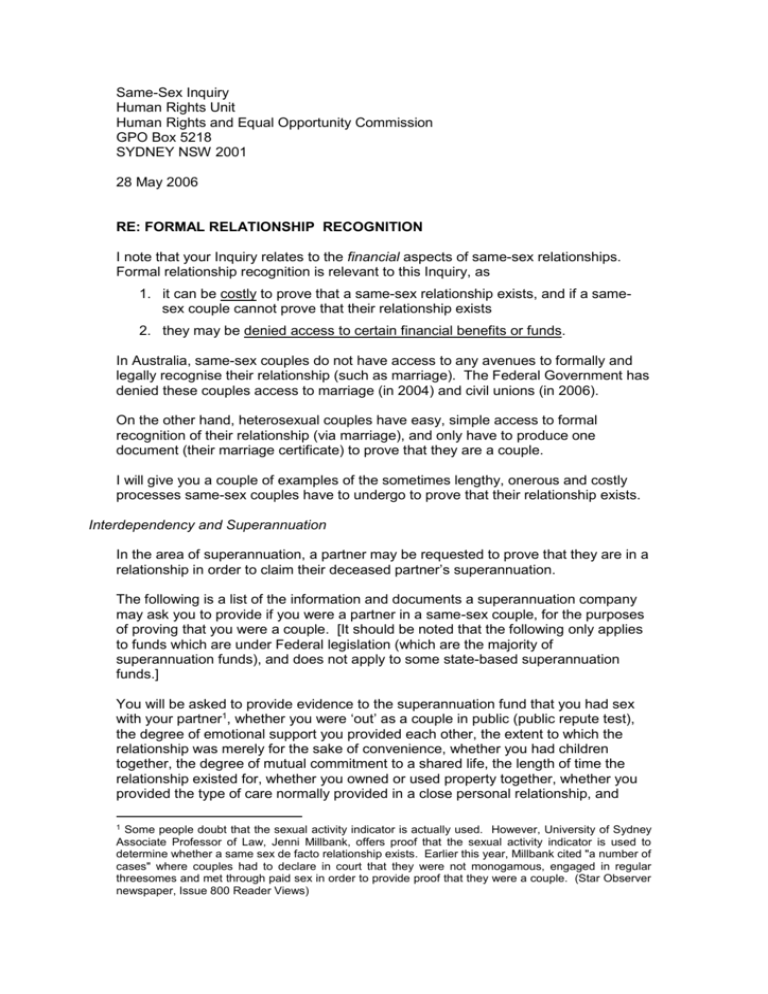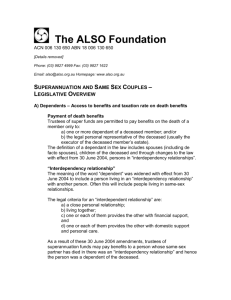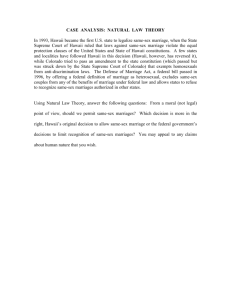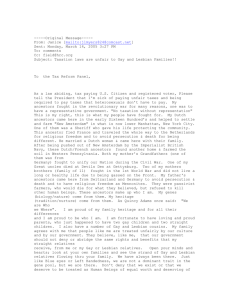
Same-Sex Inquiry
Human Rights Unit
Human Rights and Equal Opportunity Commission
GPO Box 5218
SYDNEY NSW 2001
28 May 2006
RE: FORMAL RELATIONSHIP RECOGNITION
I note that your Inquiry relates to the financial aspects of same-sex relationships.
Formal relationship recognition is relevant to this Inquiry, as
1. it can be costly to prove that a same-sex relationship exists, and if a samesex couple cannot prove that their relationship exists
2. they may be denied access to certain financial benefits or funds.
In Australia, same-sex couples do not have access to any avenues to formally and
legally recognise their relationship (such as marriage). The Federal Government has
denied these couples access to marriage (in 2004) and civil unions (in 2006).
On the other hand, heterosexual couples have easy, simple access to formal
recognition of their relationship (via marriage), and only have to produce one
document (their marriage certificate) to prove that they are a couple.
I will give you a couple of examples of the sometimes lengthy, onerous and costly
processes same-sex couples have to undergo to prove that their relationship exists.
Interdependency and Superannuation
In the area of superannuation, a partner may be requested to prove that they are in a
relationship in order to claim their deceased partner’s superannuation.
The following is a list of the information and documents a superannuation company
may ask you to provide if you were a partner in a same-sex couple, for the purposes
of proving that you were a couple. [It should be noted that the following only applies
to funds which are under Federal legislation (which are the majority of
superannuation funds), and does not apply to some state-based superannuation
funds.]
You will be asked to provide evidence to the superannuation fund that you had sex
with your partner1, whether you were ‘out’ as a couple in public (public repute test),
the degree of emotional support you provided each other, the extent to which the
relationship was merely for the sake of convenience, whether you had children
together, the degree of mutual commitment to a shared life, the length of time the
relationship existed for, whether you owned or used property together, whether you
provided the type of care normally provided in a close personal relationship, and
1
Some people doubt that the sexual activity indicator is actually used. However, University of Sydney
Associate Professor of Law, Jenni Millbank, offers proof that the sexual activity indicator is used to
determine whether a same sex de facto relationship exists. Earlier this year, Millbank cited "a number of
cases" where couples had to declare in court that they were not monogamous, engaged in regular
threesomes and met through paid sex in order to provide proof that they were a couple. (Star Observer
newspaper, Issue 800 Reader Views)
provide evidence suggesting that both parties intended for the relationship to be
permanent.
You will be asked to supply statutory declarations, copies of bills in both your name
and your partner’s name, copies of other documents showing the same address, and
proof of payments you made for your partner and visa versa.
In addition, you will be asked to approach your friends, relatives and associates to
ask them to write statements describing your relationship including any domestic
support and/or personal care you provided each other.
It will be up to the superannuation fund representative to decide whether or not your
relationship actually exists and therefore whether or not to give you your deceased
partner’s superannuation funds.
The above information was gained from the attached correspondence I received from
superannuation funds. Please note that while not all of the points need to be
satisfied, the attached correspondence from [name removed] [a superannuation
fund] does specify that the Superannuation Fund Trustee must consider each of the
above criteria when making their determination as to whether they are a couple.
Same-sex couples/partners are therefore in a financially precarious position. In the
event of one’s death, they have no certainty that their partner will receive their
superannuation, as it is up to the person assessing their claim to interpret whether or
not they have met the criteria. In addition, information about the types of evidence
that the Trustee requires are also often not commonly known or available, and
requirements can vary from fund to fund. Unlike the AUSTRAC 100 points
identification system where one can be absolutely certain whether one has enough
points to satisfy the requirements, there is no such system for proving a same-sex
relationship exists and therefore a couple cannot be certain that they possess
enough evidence to satisfy a Superannuation Trustee.
As one can see, same-sex partners are requested to supply a plethora of information
and evidence from superannuation funds, and understandably this information and
evidence can take months to gather and is an onerous, lengthy process.
It also occurs at a harrowing time in one’s life – the death of one’s partner – where
one’s mental state may not be clear enough to adequately gather all of the requested
information (and as such, one may be denied access to the funds). Furthermore to
be requested to supply declarations describing one’s sex life, or to supply evidence
to prove that the relationship was not merely for the sake of convenience is insulting,
especially at a time of bereavement.
This above process is called proving the couple’s interdependency status, and is
similar to the criteria used to prove de facto status. This applies to all de facto
couples, whether the partners are of the same-sex or opposite sex.
Presumably if there is a dispute, then the partner can take the superannuation fund
to court in order to prove that they were in a legitimate relationship with the
deceased. This would most likely be a costly process.
However, opposite-sex (ie heterosexual) de facto couples have the option of
marrying if they wish to avoid undergoing such an onerous and potentially costly
process. They have the option of marriage if they want to be certain that the
surviving partner will definitely receive the deceased partner’s superannuation.
Same-sex couples do not have this choice.
In fact, married heterosexual couples need only submit their Australian marriage
certificate to prove that they are a couple – nothing further – they do not even have to
prove that they lived together or that they still cared for one another at the time of
death (unlike interdependent couples).
Even if the Government did not wish to institute formal recognition of same-sex
relationships, there could be a superannuation form or declaration that same-sex
partners could sign whilst both partners were still living, to show that both partners
believed that they were in a binding, committed relationship together. Perhaps this
could avoid having to comply with these onerous, lengthy requests at such a difficult
times in one’s life.
Of course the preferred and simplest option would be to provide formal recognition of
same-sex unions (for example in the form of civil unions or marriage). Accordingly,
this certificate would provide easily-recognisable proof Australia-wide of the
existence of the relationship.
One superannuation fund in the attached correspondence, [name removed] even
describes the process of determining interdependency as “a complicated process”.
This would be simplified for all concerned if same-sex couples had access to formal
relationship recognition.
De Facto Relationships and Court Orders
In most Australian states and territories, same-sex couples have access to informal
de facto recognition of their relationship. However, proving the existence of one’s de
facto relationship "is a difficult process which has to refer to a large number of
indicators," advises the ACT Department of Justice and Community Safety in its
2005 relationships discussion paper (emphasis mine).
If there is a dispute about whether a same-sex de facto relationship exists the parties
may have to go to Court to prove that their relationship exists.
The Registry of Births, Deaths and Marriages NSW have informed me that:
“If there is a dispute concerning the existence of a de facto relationship
between family members of executor, and the claimed de facto partner, a
court order (Property Relationships Act) confirming or refuting the
relationship is required before the death will be amended. (emphasis mine)”
Court cases often cost thousands of dollars, and you may be required to answer
personal questions (for example about your sexual activity) in a public forum.
On the other hand a marriage ceremony is relatively inexpensive and costs $262 at
the NSW Registry. Same-sex couples are not able to access this option and are
therefore financially disadvantaged in respect of the cost of the processes they may
need to undergo in order to prove their relationship exists. (eg. $262 vs $1000s)
Same-sex couples do not have access to a reliable, inexpensive, non-onerous
process or ceremony which provides legal proof that their relationship exists, and as
such they (or their partner) may also be denied access to funds or property which
requires them to first prove they are a member of a couple.
Yours faithfully
Walter Lee
[Details removed]




![Peter Collard [Details removed] Dear Sir and/or Madam National](http://s3.studylib.net/store/data/007613680_2-0e9d06f34ba7c7a5a822dec6a16b6bcf-300x300.png)



